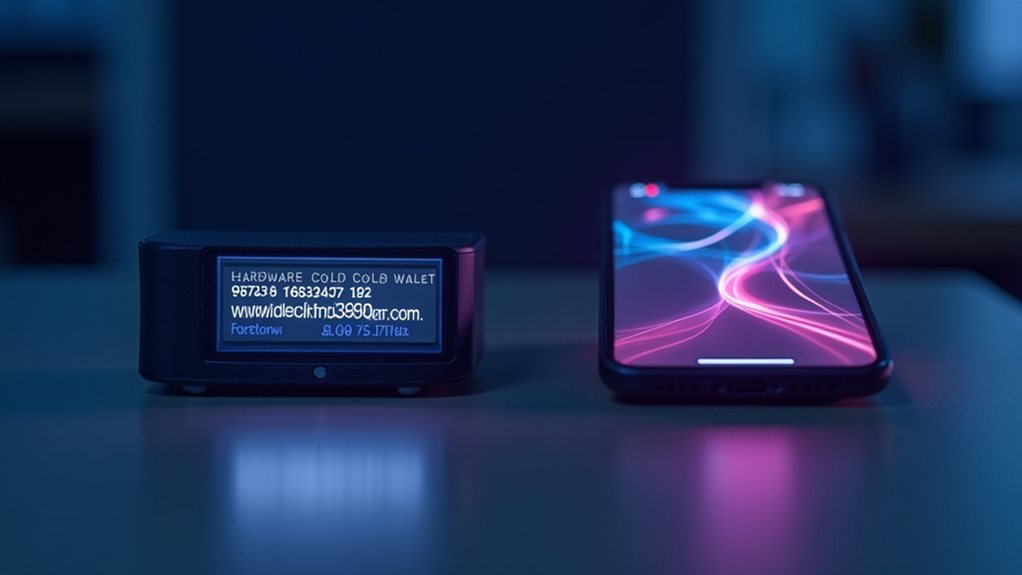Cold wallets keep your crypto offline and safe from hackers, while hot wallets stay connected to the internet for easy transactions. Hardware wallets never expose your private keys online—they’re practically digital fortresses. Mobile and desktop wallets? Convenient but vulnerable. Your seed phrase is everything; lose it, kiss your crypto goodbye. Never store it digitally, and consider metal backups. The difference between security and convenience might just save your digital fortune.
Understanding the Basics of Cryptocurrency Storage

Security. It’s literally everything when it comes to your crypto. Unlike traditional money sitting in a bank, your digital assets are only as safe as the private keys that control them. No keys, no crypto. Simple as that.
Your cryptocurrency basics start with understanding that these private keys are the true asset you’re protecting. Not the coins themselves. Private key management isn’t optional—it’s survival in the crypto world. Two-factor authentication adds an essential layer of protection for your digital assets.
Think of your wallet as a keychain, not a piggy bank. It doesn’t “hold” your coins; it holds the keys to access them on the blockchain. Hardware wallets offer advanced security by storing these keys offline, completely isolated from internet threats.
Cold storage is preferred for long-term investments since it keeps your assets in an offline environment completely disconnected from potential online vulnerabilities.
Hot or cold storage? That’s your call. Depends entirely on your needs. Daily trading? Long-term holding? Your choice affects your risk. Always does.
What Makes Hot Wallets Convenient for Daily Transactions
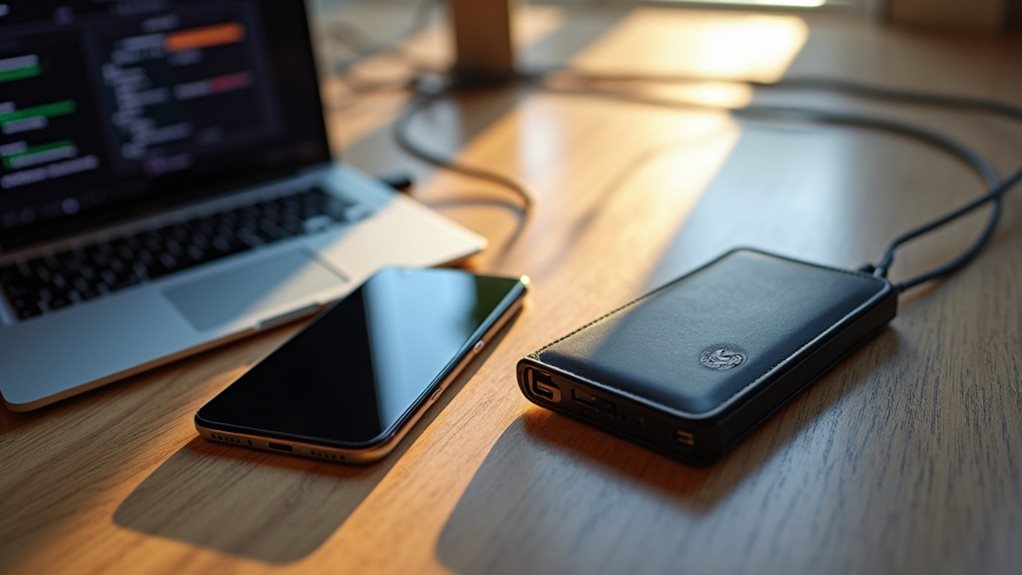
Now that you’ve got the lay of the land, let’s talk hot wallets. They’re ridiculously convenient. Period.
What makes them so great? Instant access, for starters. With an internet connection, you’re transferring crypto in seconds—not minutes, not hours. Transaction speed matters when markets move fast. The user experience is deliberately simple—even your technophobic uncle could figure it out. No extra hardware needed.
Hot wallets shine for everyday crypto life: small transfers, DeFi dabbling, NFT shopping, or quick trades. They work seamlessly with exchanges and support multiple cryptocurrencies in one place. Browser extensions like MetaMask connect you directly to the Web3 world. Trading during peak trading hours between 2:30 PM and 4:30 PM UTC can maximize your market opportunities.
Sure, they’re less secure than cold storage. That’s the trade-off. Popular options like Trust Wallet and Exodus offer enhanced security features like two-factor authentication to help protect your assets. But for daily transactions? Nothing beats them.
Active traders especially benefit from hot wallets due to their constant availability for frequent cryptocurrency transactions.
The Security Advantages of Cold Storage Solutions
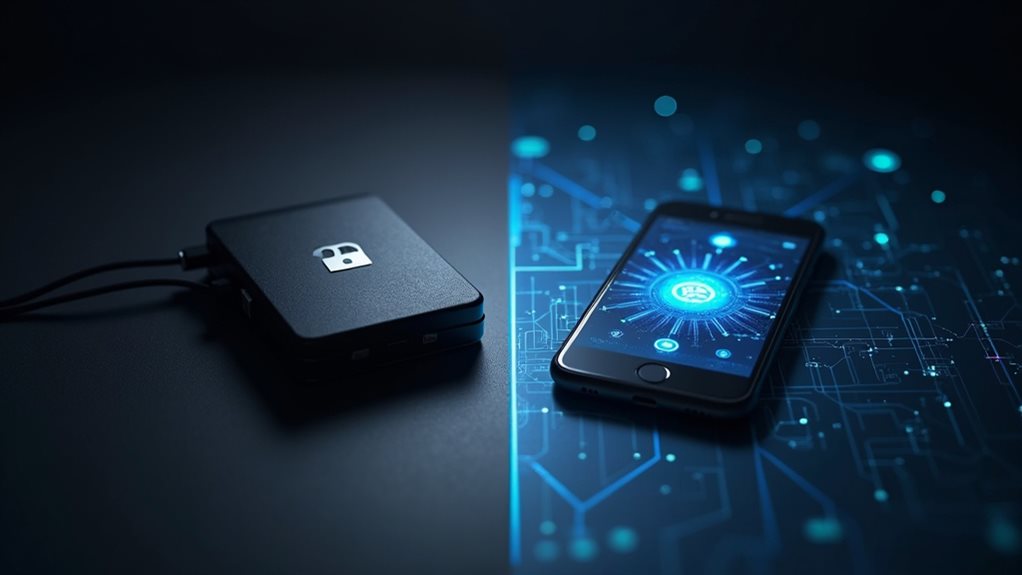
While hot wallets offer convenience, cold storage solutions provide an entirely different level of security that serious crypto holders can’t ignore.
Cold wallet benefits revolve around complete isolation from the internet. Your private keys stay offline—always. Period. No hackers, no phishing scams, no malware can touch them. The security relies on hardware devices specifically designed for cryptocurrency storage.
Offline security means you’re in control, not some exchange that might get hacked tomorrow. Remember Mt. Gox? Exactly. With cross-chain attacks causing over $2 billion in losses during 2024, offline storage has become more crucial than ever.
- That gut-wrenching feeling when you read about another exchange hack? Gone.
- The peace of mind knowing your life savings aren’t accessible to every keyboard warrior with coding skills? Priceless.
- The satisfaction of being your own bank, truly owning your crypto? Unmatched.
Cold storage isn’t just safer—it’s practically bulletproof against digital threats. With a staggering $1.7 billion stolen from exchanges in 2023 alone, the importance of secure offline storage cannot be overstated.
Key Vulnerabilities of Internet-Connected Wallets

Hot wallets exist on the digital equivalent of thin ice.
They’re constantly exposed to key exposure risks, with 17% of CEX hacks exploiting API vulnerabilities that reveal your transaction patterns.
Think that’s bad? Unauthorized access causes 29% of breaches, often because people can’t be bothered with decent passwords or 2FA.
Phishing tactics have evolved beyond “Nigerian prince” emails.
Now they’re personalized, AI-generated traps waiting for you to click.
With trading volume down 54% since December, hackers are getting more desperate and creative in their attempts to steal funds.
Malware risks are everywhere—scanning your RAM, monitoring your keystrokes, waiting patiently.
Your device’s memory is an open book. Outdated SMS-based 2FA contributed to a 32% rise in account takeovers in 2025, making traditional verification methods increasingly vulnerable.
Recent attacks like the WazirX hack demonstrate how attackers can exploit even multi-signature setups to drain millions.
Security protocols matter.
Access controls matter.
Backup strategies matter.
But let’s be real—user awareness is your first line of defense.
The internet is a battlefield, and your hot wallet is standing in the open wearing a neon “ROB ME” sign.
Hardware Wallet Options and Their Protective Features

Security upgrades aren’t just nice-to-haves—they’re vital in the crypto wilderness.
Hardware wallets deliver serious protection with secure elements and offline key generation—your private keys never touch the internet. Period.
The recent Bybit security breach demonstrates why robust offline storage solutions are essential for crypto assets.
When shopping for hardware wallet features, consider these key components:
- Physical protection matters. The Ellipal Titan’s rugged build and SafePal’s self-destruct mechanism aren’t overkill—they’re peace of mind.
- Interface options affect daily use. Touchscreens (like on the Ledger Stax) make life easier, but USB-only models might be more secure.
- Price doesn’t always equal protection. The $50 SafePal offers solid security, while the $279 Ledger Stax delivers convenience.
Connectivity options vary wildly. Bluetooth? Convenient but potentially risky. The Ledger Nano X offers Bluetooth connectivity for mobile access while maintaining security.
Want absolute security? Stick with USB.
Security certifications aren’t just fancy badges—they’re your sanity insurance.
Many premium hardware wallets now support staking capabilities that allow you to earn passive income while keeping your assets secure offline.
Creating a Balanced Crypto Security Strategy
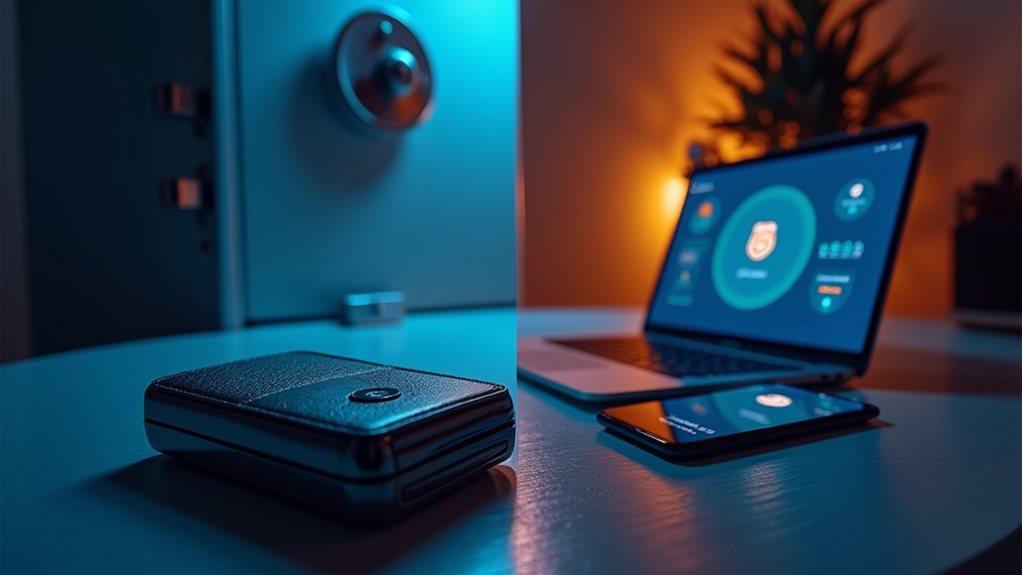
Creating a solid crypto security strategy isn’t a luxury—it’s your financial lifeline. Seriously. Your coins disappear with one mistake.
Start with user training—recognize phishing attempts before they hook you. No Nigerian princes here, folks.
Phishing emails don’t wear crowns—they wear convincing masks. Train your eyes to spot the deception.
Implement robust access control using multi-factor authentication on everything. Yes, everything. Consider using authenticator apps instead of SMS codes for better security.
Layer your security protocols like an onion. Cold storage for long-term holdings, hot wallets with minimal funds for daily use. Smart.
Don’t skimp on encryption techniques or wallet backup procedures. When disaster strikes—and it will—incident response plans save your digital bacon.
Threat detection systems should monitor transactions 24/7. Protecting your private keys with hardware wallets provides significantly stronger security against potential breaches.
Compliance standards aren’t just corporate buzzwords—they’re frameworks that keep your assets safe.
Remember: paranoia in crypto isn’t a mental disorder. It’s survival.
Consider implementing multi-signature wallets for enhanced security as they require multiple private keys for transaction authorization.
Risk Assessment: How Much Should You Keep Accessible

The most dangerous question in crypto isn’t “which coin will moon?”—it’s “how much should I keep readily accessible?”
Now that you’ve built your security fortress, you need to determine what belongs in the vault versus your pocket. Your risk appetite shapes everything. Proper risk assessment protocols are essential for preventing illicit activity while maintaining appropriate access to your crypto assets.
Hot wallets connected to the internet? Yeah, they’re convenient—and hackers love them. Cold storage might be a pain, but so is losing everything. Finding balance means honest exposure assessment of your actual needs. With DeFi platform breaches becoming more frequent in 2025, cold storage has never been more critical.
- That gut-wrenching feeling when markets crash while your funds sit unprotected in a hot wallet
- The frustration of missing opportunities because your assets are locked in cold storage
- The peace of mind from knowing you’ve implemented proper security protocols
Regulatory considerations matter too. Wallet screening against sanctions isn’t just compliance fluff—it’s protection. Wallet screening serves as a crucial compliance tool to evaluate blockchain wallets before engagement with them.
Technological safeguards must scale with your accessible amounts. Volatile assets? Keep less accessible. Simple.
Protecting Your Seed Phrases and Recovery Keys
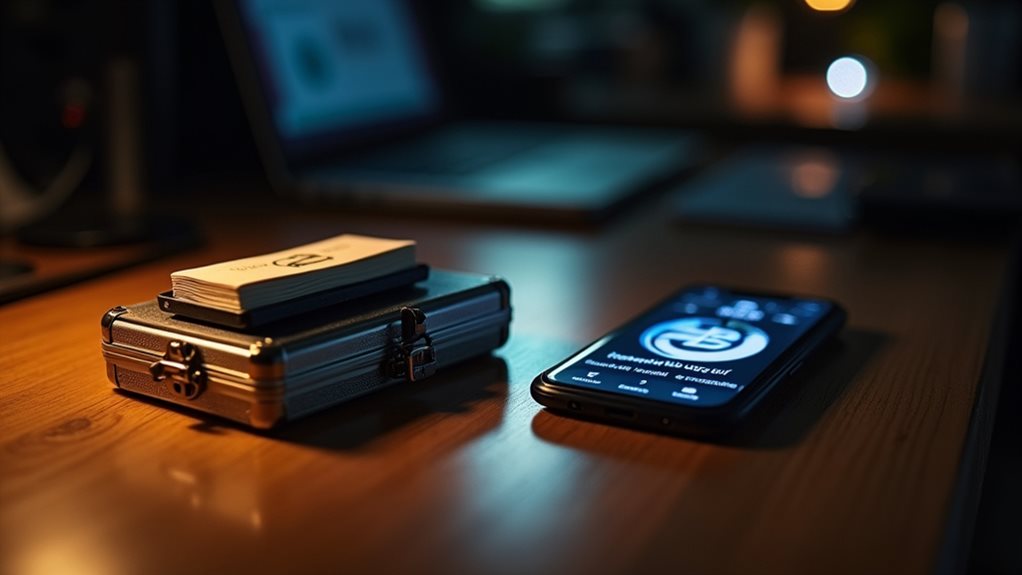
Your seed phrase isn’t just a random string of words—it’s the master key to your entire crypto kingdom. Lose it, and you’re toast. No, seriously.
Never store seed phrases digitally. Ever. Paper backups are cheap but fragile—metal devices are way better for serious hodlers.
Effective seed phrase management means thinking long-term. Store backups in fireproof safes and create geographical redundancy. Yeah, that means multiple locations. With lost wallet recovery rates at only 2.5%, you can’t afford to take chances with your backup strategy.
For extra protection, add a passphrase (that “25th word”). Just don’t forget it. There’s no “forgot password” button in crypto.
Common backup strategies that’ll get you rekt: taking photos, storing on computers, or—heaven forbid—sharing with “helpful support staff.”
Write phrases down exactly as shown, check them regularly, and tell exactly one trusted person where they are. Not what they are. Remember that no central authority exists to help you recover your funds if you lose access to your seed phrase.
When writing down your seed phrase, consider using acid-free paper and pencil rather than pen to ensure your backup withstands the test of time.
Mobile vs. Desktop vs. Hardware: Choosing the Right Wallet

When it comes to wallet choice, you’re fundamentally picking your security comfort level—and there’s no one-size-fits-all solution.
Mobile wallet benefits include convenience and on-the-go access, but they’re always online—making them more vulnerable to hacks. These app-based solutions provide easy accessibility for managing your crypto on the move. Many hot wallets like Trust Wallet offer extensive support for NFTs and Web3 projects while maintaining user-friendly interfaces.
Desktop wallet trade-offs offer better security than mobile options while still maintaining decent usability. They’re less exposed but still not impenetrable. Using two-factor authentication adds an essential layer of protection for your digital assets.
Hardware wallet comparisons consistently show they’re the gold standard for security. Period. Offline storage means hackers can’t touch your keys remotely.
Yeah, they cost money ($50-170), but what’s your peace of mind worth?
- That pit-of-your-stomach feeling when you read about another exchange hack
- The relief of knowing your life savings aren’t accessible via public WiFi
- That smug satisfaction when wallet integration features let you combine security with convenience
Best Practices for Transferring Between Hot and Cold Storage
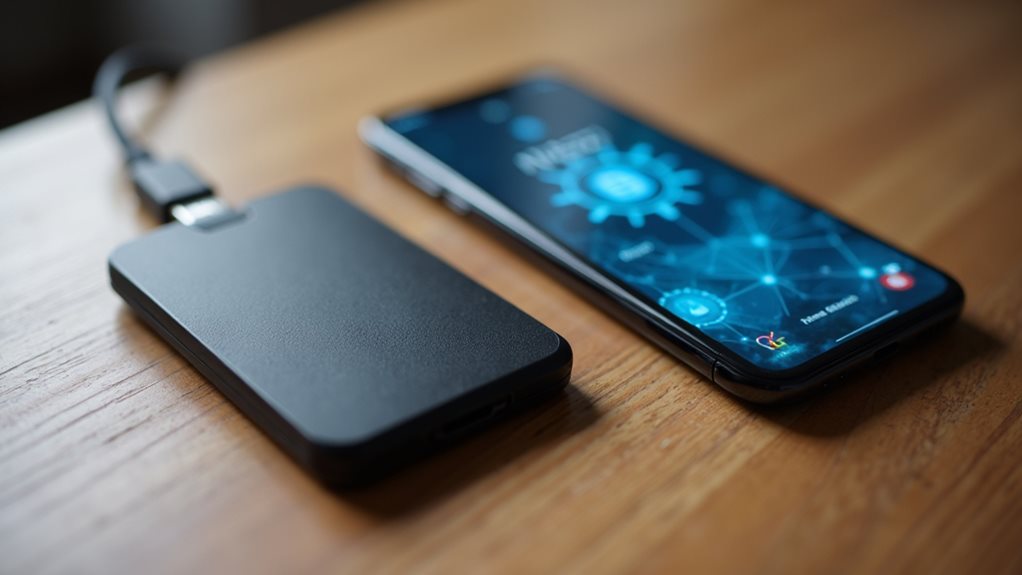
Now that you’ve selected your wallet, moving your crypto between hot and cold storage represents a critical security checkpoint. Mess this up, and your digital fortune vanishes. Forever.
Always verify receiving addresses directly on your cold wallet’s screen before transferring. Those fancy transfer protocols aren’t foolproof if you’re careless.
Trust your hardware, not your screen. Verify every address directly on your cold wallet before hitting send.
When sending from hot wallets, double-check everything—network, address, amount. No do-overs in crypto.
For withdrawals from cold storage, sign transactions offline. Period. This is where hardcore security measures pay off. Never, ever expose your private keys online unless absolutely necessary.
Use official wallet software only. Sketchy apps? Might as well hand your crypto to strangers on the street.
Monitor your transactions. Blockchains get congested. Be patient, not paranoid. Begin with a small test transfer amount before moving larger sums to ensure everything works correctly. Consider your transaction fees carefully, as they vary based on network congestion and can significantly impact confirmation times.
Frequently Asked Questions
Are Wallet Recovery Services Legitimate if I’ve Lost Access?
Some wallet recovery services are legitimate, but you’ll need to verify their credibility. Watch for red flags like upfront fees, unrealistic promises, and requests for your private keys. Only trust services with proven service legitimacy.
How Do Inheritance Plans Work for Crypto Wallets?
You’ll need formal inheritance planning that specifies beneficiaries and access methods for your crypto. Include wallet transfers in legal documents, store credentials physically, and consider trusts for privacy—they’re better than wills for crypto.
Can Quantum Computing Threaten Cold Wallet Security?
Yes, quantum computing threatens cold wallet security. Your wallet’s vulnerabilities lie in quantum threats to cryptographic algorithms. Once quantum computers advance enough, they’ll break encryption and potentially derive your private keys from public addresses.
What Insurance Options Exist for Crypto Wallet Holdings?
You’ll find several crypto insurance options: cyber liability, crime, custody, business interruption, and smart contract failure policies. For your wallet coverage, look into retail policies that reimburse theft from security breaches but won’t cover lost keys.
How Do Tax Authorities Track Transactions Across Different Wallets?
Tax authorities track your crypto through blockchain analysis, exchange reporting, and wallet surveillance. They’ll monitor transaction tracking across wallets, requiring wallet-by-wallet accounting while using KYC data to link your digital activities to your identity.
